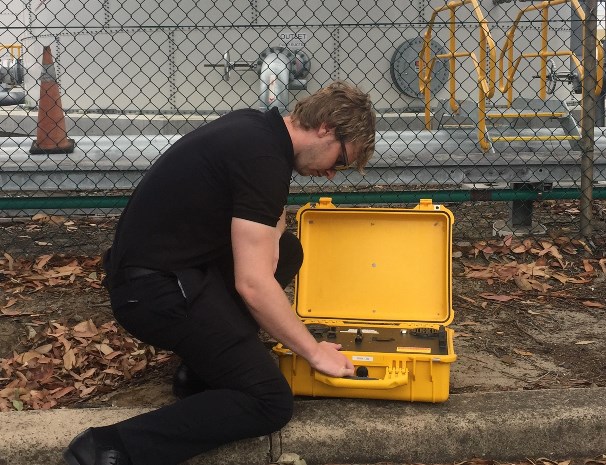Recent improvements made in portable x-ray diffraction (XRD) technologies are allowing industry users in remote locations to cut costs and boost efficiencies, according to officials involved with the development and marketing of the units.
For remote mining operations or offshore energy production facilities, the cost of corrosion testing is often increased significantly by the need to transport any affected asset to a specialist laboratory, the officials say. Even in major metropolitan areas, it can still take weeks for laboratories to analyze samples. For proper inspection, a corrosion engineer or chemist should view all relevant information so they can identify any corroded products and plan the proper repair and maintenance strategies. Historically, this process can go on for weeks and also prolong the downtime of an asset.
However, comprehensive compositional materials analysis can now be carried out on location at a work site using portable field analyzers.
According to Dane Burkett, product specialist with nondestructive testing (NDT) technologies group Olympus (Waltham, Massachusetts), field analyzers allow asset owners to analyze their corrosion samples directly on an oil platform, remote plant, or refinery.
The analyzer works as a self-contained, battery operated, closed-beam XRD system that provides full phase identification of major, minor, and trace components. The unit then combines XRD and qualitative x-ray fluorescence (XRF) analysis in a single instrument, with seamless integration of data and results. The sample preparation and operation do not require detailed technical knowledge, so anyone on the jobsite can run the test, Burkett says.
Deeper Findings
In addition to the added mobility, Burkett says the XRD system is also beneficial to asset owners due to the increased depth and quality of information.
“Traditional analysis of corrosion products only indicates their presence, or their chemical composition, such as iron-bearing corrosion,” says Burkett. “XRD can identify and quantify corrosion and scaling products—for example magnetite, or akaganeite—by characterizing their crystallographic structure.”
The crystallographic structure of corrosion and scaling products is unique, much like a fingerprint. XRD is then used to define this characteristic structure, Burkett explains. XRD works by subjecting a sample to a monochromatic x-ray beam and measuring the angles at which the x-rays diffract. A combination of diffraction angles is characteristic of a given phase of a particular corrosion or scaling product.
Unlike some other methods that identify compounds, XRD can identify and quantify all crystalline phases, regardless of reflectance. In addition, XRD can distinguish between different corrosion and scaling products that have similar chemistry. For example, when using XRD, the ferrous corrosion products goethite, lepidocrocite, feroxyhyte, and akaganeite can be distinguished from each other, Burkett says, even though they all have the chemical formula FeO(OH).
According to Burkett, the identification of compounds—as opposed to elemental compositions—is crucial to understanding corrosion processes.
“Different corrosion and scaling products form under different conditions and in different environments,” Burkett says. “Information about the presence and quantity of these phases is not only helpful in explaining the corrosion process, but can help to determine the root cause, locate the origin of corrosion in a facility and, at the same time, indicate possible solutions to the problem.”
Once a corrosion or scaling product is identified, it is then possible to determine the temperature, pressure, fluid chemistry, and pH conditions under which it formed.
“If you know what it is, then you can determine the best way to treat it,” Burkett says. “This might be with an acid wash or adding some type of inhibitors into the process.” Other treatments can include the use of bactericides, alternative or enhanced coatings, milling the inside of the machinery, or replacement of the equipment.
Knowing how corrosion products form can also allow an engineer to optimize a process to stop or slow their occurrence. For example, the temperature or pressure parameters can be adjusted, or leaks can be located and repaired.

Technology Details
The technology inside the XRD units was initially conceived to perform chemical and mineralogical testing for NASA’s Mars Science Laboratory (MSL) mission.
Using a specifically developed direct excitation charge coupled device (CCD) camera, the units are able to collect x-ray photon data for both XRD and XRF simultaneously. The camera can detect both photon position and photon energy at the same time.
In other words, the unit can use XRD to measure and quantify corrosion products, while using XRF to examine qualitative chemistry. With energy resolution of ~200 eV, the XRF analysis is as simple as viewing the software spectrum display.
The unit also simplifies the sample preparation, loading, and unloading steps for XRD experiments. According to Burkett, a technician can be trained to load a sample within a matter of seconds.
To ensure a random orientation of crystals, a sample vibration chamber built into the unit eliminates the usual requirement to finely grind grains to less than 10 μm before pressing the sample into a pellet. Instead, requiring a mere 15 mg sample at less than 150 μm, the vibration chamber’s convection process presents the instrument optics with multiple orientations of the crystalline structure.
The resulting XRD pattern is then essentially free of “preferred-orientation effects,” Burkett says, noting that those are often encountered when using lab-based XRD instruments.
The powder-handling system, non-mechanical goniometers to measure angles, and lack of complex moving parts makes the units ideal for applications where field portability and ease of use are important. Burkett says the units can be used for a wide range of applications—led by corrosion monitoring—and across a number of industries, including oil and gas, forensics, and mining.
Source: Olympus, www.olympus-ims.com. Contact Olympus—E-mail: IBDinfo@olympus.com.au.